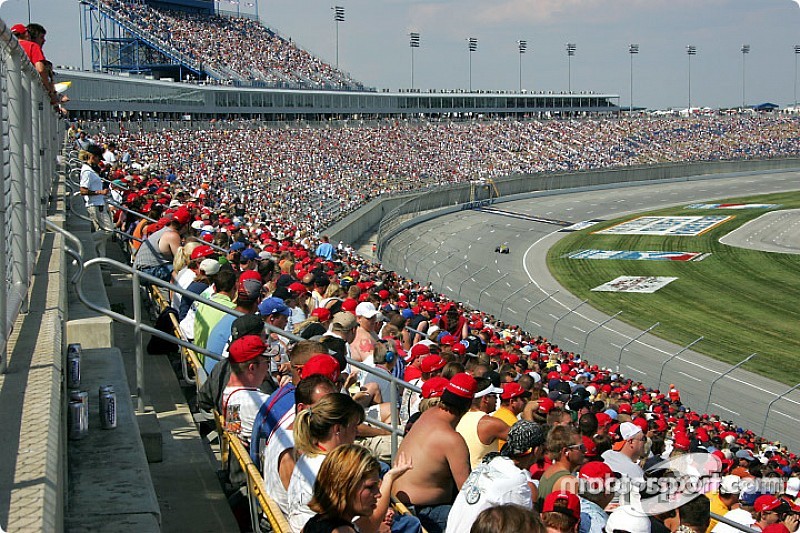What does NASCAR's new lower-downforce package mean for teams?
Yes, the sanctioning body confirmed a new body style is in the works for Kentucky, but just how do Sprint Cup teams expect to get up to speed before the first practice on July 8?

Photo by: Ron McQueeney
When NASCAR first told Sprint Cup teams last week that changes could be coming to the Kentucky Speedway aero package the real race began.
Once teams received the rules under which the cars would operate, strategies for the lower downforce model went into motion and teams were in the wind tunnel by Wednesday evening.
A quick review of the alterations of the Generation 6 Kentucky Speedway package:
The rear spoiler will be shortened from six inches to 3.5 inches, the front splitter overhang will be shortened by 1 ¾ inches and the splitter extension panel will be decreased from 38 inches-wide to 25 inches.
From the driver’s seat, the new aero package should provide competitors with the feel of an additional 110 horsepower which will hopefully encourage passing on the race track.
As Steve O'Donnell, NASCAR's Executive Vice President and Chief Racing Development Officer, said on Tuesday, the garage as a whole is fairly nimble and able to make modifications quickly.
“These are in essence bolt-on parts and pieces that most of the teams have,” O’Donnell said. “So when we say we've talked to the race teams, that is all of the race teams. They've all been included in this dialogue. We kept all of that in perspective prior to announcing that we were going to go forward in Kentucky with the feeling that everyone would have a great shot at being ready to go for the race. That's why we're also opening up on a Wednesday.
“And candidly, it's also a little bit of a reason that you see this isn't an announcement eight months in advance. We don't want 55 wind tunnel testing done on this package. That's part of this is we look at it as a little bit of an equalizer, as well, with the timing, and the teams seem to feel that way, also.”
Getting up to speed
Most teams already had their Kentucky cars in the pipeline. According to one top general manager, “In general you don't have to build a new car from scratch for the new rules. You are always working on understanding how the aerodynamics of the cars work, like for example how does the flow under the pan and splitter affect the rest of the underbody, etc.
"The new rules may change that a little but as you understand more you can react fairly quickly.”
Although it’s 25 days until the fans arrive for the Quaker State 400, teams must be ready to practice on July 8, when NASCAR opens up Kentucky Speedway one day early for a four-hour night test.
As mentioned earlier, most teams scheduled wind tunnel time immediately to develop and aero map to measure the variety of ride heights around the 1.5-mile track. The aero map is used for vehicle dynamics simulations.
The biggest question will be the tire — since it was not designed to match the package. Ryan Newman, Jamie McMurray, Greg Biffle and Brett Moffitt participated in a two-day tire test at the Sparta, Kentucky track in April. On Wednesday, April 15, Dale Earnhardt Jr., Brad Keselowski, Matt Kenseth, Sam Hornish Jr., Danica Patrick and Ryan Blaney joined for the open test. Despite the data gathered at the tests, teams will have the challenge to develop the baseline setups for the Quaker State 400.
While competition focuses on setup, engineers will return to the wind tunnel and continue to analyze the computational fluid dynamics of the car to regain some of the downforce that was lost.
“Less spoiler on the back has a lot less drag and that tilts the bias towards creating more downforce and worrying less about drag,” a source familiar with the package told Motorsport.com. “The lap times are usually a function of aerodynamic efficiency which is lift/drag.
“This is particularly so when the total drag and engine are such that you are close to reaching a flat line or critical speed on the straightaway. In that case to improve efficiency you work a little harder on the drag side, trying to lower that while at the same time increasing lift/drag. As drag goes down lift/drag goes up since its in the denominator.
“However most drag improvements come with a downforce loss so you have to balance those and pick the drag changes that don't lose as much downforce, therefore increasing lift/drag. When the drag goes way down and there is a larger difference between engine power and drag then the downforce side (the lift) of lift/drag becomes king.”
Where the rubber meets the road
The final challenge for teams is to ascertain what aspects of the Kentucky car configuration will be used moving forward — and therefore, how much time and effort should be invested?
O’Donnell said, “This is a Kentucky package only, but any options are on the table coming out of Kentucky. But for now, that's been the dialogue with the industry.”
Be part of Motorsport community
Join the conversationShare Or Save This Story
Subscribe and access Motorsport.com with your ad-blocker.
From Formula 1 to MotoGP we report straight from the paddock because we love our sport, just like you. In order to keep delivering our expert journalism, our website uses advertising. Still, we want to give you the opportunity to enjoy an ad-free and tracker-free website and to continue using your adblocker.























Top Comments